How to Spend One Day in Córdoba (Day Trip from Sevilla)
We loved Córdoba, and think it stands alongside Granada as one of the must-visit Spanish cities if you’re looking to explore the rich and complex history and remnants of Muslim rule in Southern Spain.
To be completely honest, we basically had no idea that there was a Muslim presence on the Iberian Peninsula for hundreds of years until we spent more than a month between Spain and Portugal a few years ago.
Everywhere we went, we heard about the wars between the Christian kingdoms and the various Muslim states until, in the 13th century, the Christians won and reclaimed southern Spain and Portugal.
However, the influence of that period of Muslim rule persists today, seven centuries after the Reconquista took place. Even the name of the region in Spanish – Andalucía – comes from the Arabic name for the same region – Al-Andalus.
There is perhaps no better place to learn about that fusing of cultures (and architectural styles) than Córdoba. And lucky for you, Córdoba is a short train ride from Sevilla (another excellent place to see that blending of cultures in action), which makes it easy to plan a day trip to Córdoba.
We ended up spending a full three days in Córdoba, and it was probably too much time for most people that are on a more fast-paced Spain itinerary.
We’ve chosen the best things to do in Córdoba based on our own experience and put them together in this guide to spending one day in Córdoba.
Please note, this guide to planning your Sevilla to Córdoba day trip will cover everything you need to know to do it independently – the logistics like how to get there and when to go, the best things to do in Córdoba, and more.
If you don’t want to worry about the logistics, we’d recommend a guided tour to Córdoba instead. Here’s a guided day trip from Sevilla with good ratings, though you won’t see all the sights we go through below.
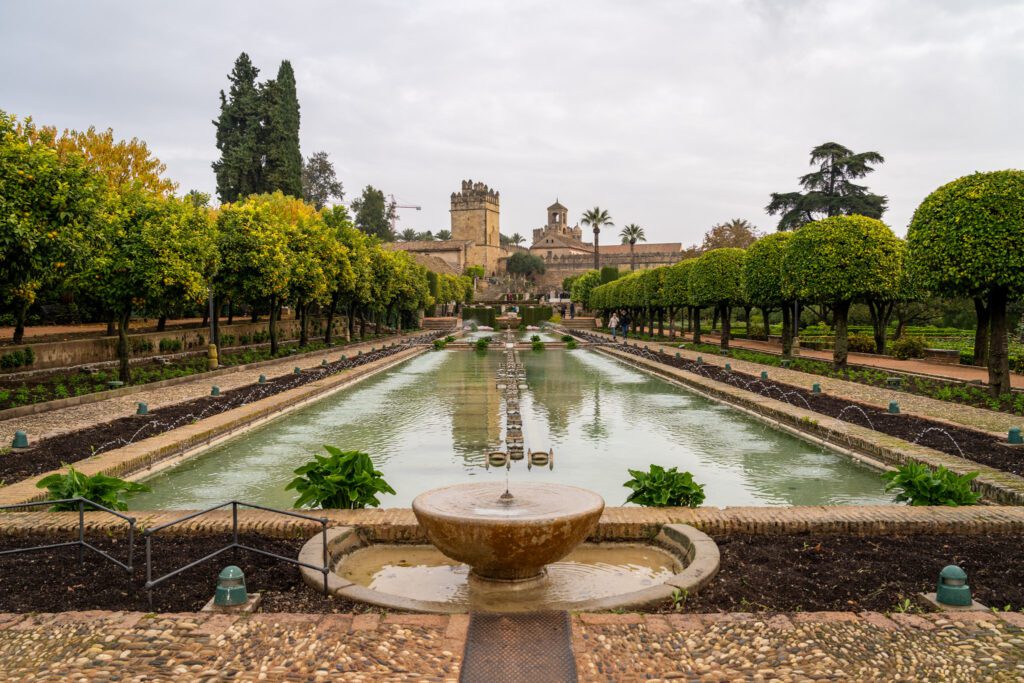
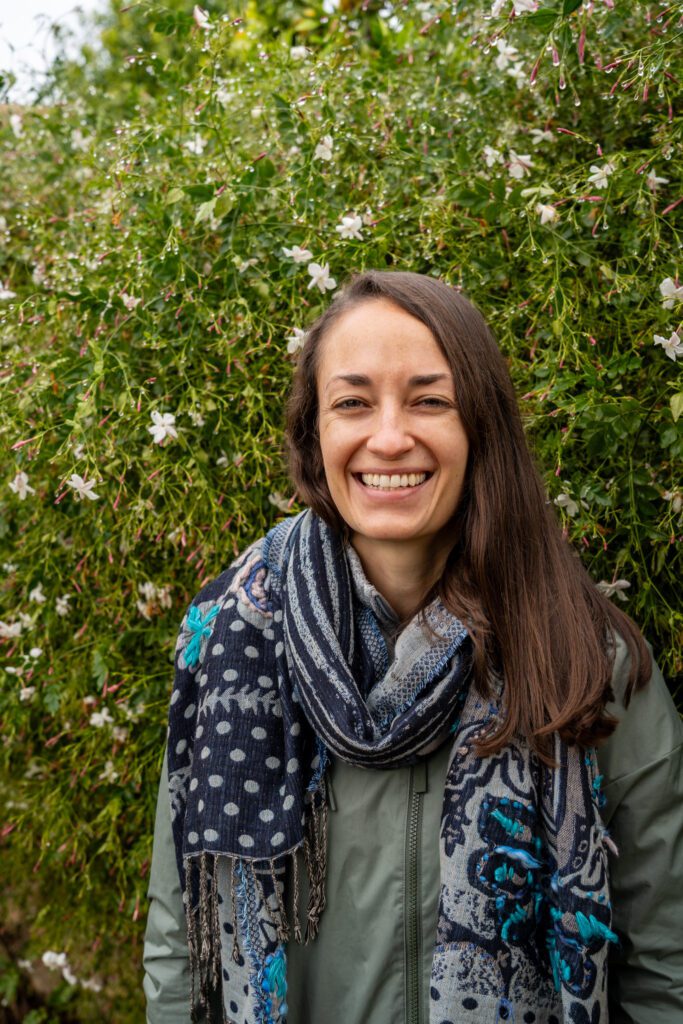
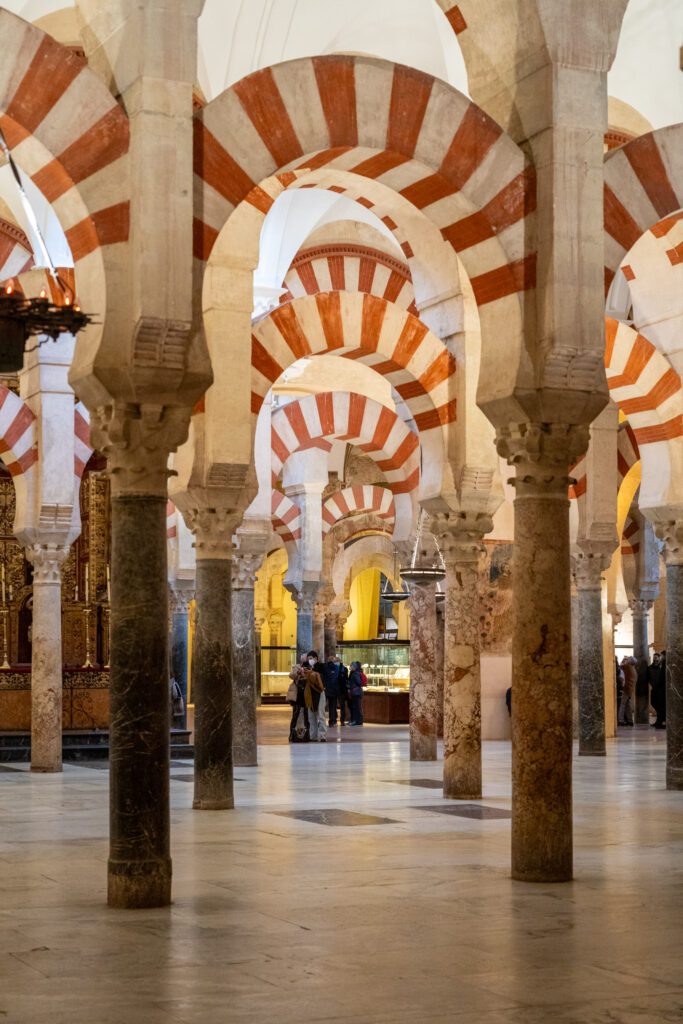
Disclaimer: Some of the links in this post, like hotel links, are affiliate links, meaning at no additional cost to you, we make a little bit of money if you click through and book. That being said, we would never recommend something to you that we don’t stand behind 100%.
Is One Day Enough in Córdoba?
The short answer is probably.
We actually spent three days in Córdoba, and it was somewhere between one and two days too many.
Of course, it also very much depends on what kind of experience you’re looking for.
If you choose to do a day trip, then you’re going to be spending your time going from place to place, without much downtime in between.
If you do an overnight in Córdoba, you’ll have more time to fit in the sights you want to see, and the pace will be more relaxed.
It essentially comes down to your style and the amount of time you have to spare in your Spain itinerary.
We think you can either do an action-packed day in Córdoba, or see essentially the same sights at a slower pace with an overnight stay in Córdoba.
We will say, it’s pretty nice being in the city in the morning and evening after all the people on day trips are gone.
Many people come to Córdoba, see the world-famous Mezquita, and then head home all within a few hours.
But we DEFINITELY think it’s worth going deeper than that. We probably wouldn’t recommend anything over two days based on our own experience.
Our recommendation – and the way we’ve structured the Córdoba itinerary below – is to spend a full day exploring Córdoba, coming in the morning and leaving in the evening after dinner.
You’ll have plenty of time to see the sights associated with the three religions – Judaism, Islam, and Christianity – and have some unique food and drink experiences before heading back to Sevilla.
Getting from Sevilla to Córdoba
The best way to get from Córdoba to Sevilla is the high speed train, which takes 40 minutes flat, leaving from Sevilla Santa Justa, the main train station in Sevilla.
This is by far the easiest and most efficient option, though it’s a little more expensive than the bus or regional trains, which both take significantly more time.
You’ll arrive at the Córdoba Train Station (here on Google Maps), which is a 15 minute walk from the main sights in town (or a €6-8 taxi).
We used Omio to book trains and buses in Spain because the official Renfe site gave us all sorts of issues when it came to paying with our American credit cards.
It’s convenient, in English, and gives you all the options – including buses (you do pay a small service fee per ticket, though).
Click here to check prices and timetables for the journey from Sevilla to Córdoba.
Going by bus might be a tiny bit cheaper, but it will take two hours each way, more than double the journey time via train.
That’s a lot of transit time for a single day in Córdoba, and we’d highly, highly recommend the train.
Can You Drive from Sevilla to Córdoba?
Driving from Sevilla to Córdoba is possible, but it can take anywhere between 1 hour 40 minutes to 2 hours, depending on traffic – longer than even the regional train.
Plus the old town of Córdoba is closed to traffic unless you’re staying at a hotel in the center, so you’ll have to park pretty far out.
Even if you have a car, we’d suggest leaving it in Sevilla and taking a day trip by train.
Getting To Córdoba From Madrid
Córdoba is located 1 hour 45 minutes away from Madrid by high speed train, so it’s pretty far for a day trip – although you could make the journey if you really wanted (though we’d argue that there are better day trips to take from Madrid, like Toledo).
However, Córdoba sits on the route between Madrid and Sevilla, so you could stop for an overnight trip on the way between the two (depending on your itinerary).
This works if you’re traveling by train or by car. If you are traveling by car, remember to book a hotel with on-site parking.
Getting Around Córdoba
We walked everywhere in Córdoba, and the longest walk you’ll have on this itinerary is likely going to be to and from the train station at about 20 minutes.
If you do find yourself needing to take the bus to get around town, it’s pretty easy. Hop on the bus, pay the driver €1.30, get your ticket, et voila! We took the bus to go on a quest to an out-of-the-way gluten free bakery, and it was smooth sailing.
We use Google Maps to find bus routes and times when we’re traveling, and it usually works like a charm.
A Complete One Day Córdoba Itinerary for First Timers
As we’ve already mentioned, we think that one day is enough time to see Córdoba’s most important attractions, including the iconic Mezquita Cathedral, stunning Alcázar de los Reyes Cristianos, and the city’s famous patios.
In the itinerary that you’ll find below, we’ll run you through our version of how to make the most of 24 hours in Córdoba.
If you are visiting Córdoba on a day trip from Sevilla, try to catch an early train so that you arrive in Córdoba somewhere between 8-9am. This itinerary will take up a full day, so you can catch your return train in the evening after dinner.
The Alcázar de los Reyes Cristianos
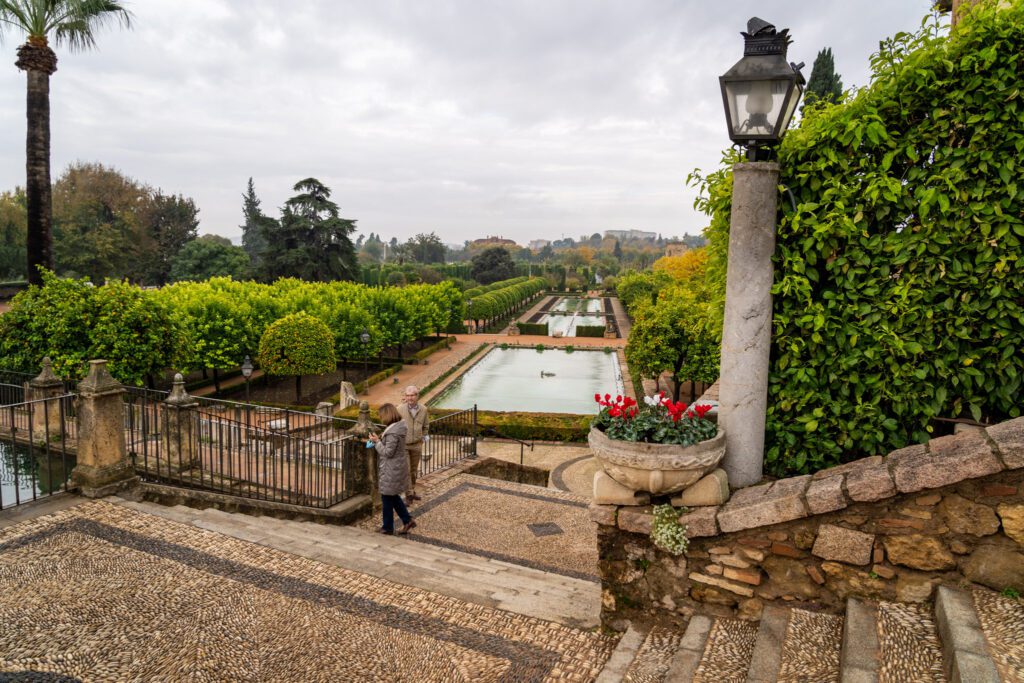
Start your day in Córdoba by heading to the south of the city center and visiting the Alcázar de los Reyes Cristianos – which translates (roughly) to “Castle of the Christian Monarchs.”
Like many present-day sites around Europe, this one was built on top of an existing site from previous inhabitants. In this case, with ancient Roman and Visigothic remains and a fortress from the Islamic Caliphate.
The beautiful palace you see here today was reconstructed by the Catholic King Alfonso XI of Castile in the 1300s after the reconquest of Spain.
The palace was designed in the unique Mudéjar style, a Christian architectural style influenced by the Islamic artists who remained in the region after the reconquest.
Crucially – and you’ll find this in Sevilla too – it was built after the reconquista, when this style of stunning architecture became trendy in now-Christian Spain, which we always find kind of funny.
Throughout its history, the palace has had many roles, including a royal residence, a prison, and even the official headquarters of the gruesome Spanish Inquisition by Queen Isabella I of Castile and King Ferdinand II of Aragon.
Today the huge palace complex has been declared a UNESCO World Heritage Site and many areas are open to the public.
Inside, you can visit the “Hall of Mosaics,” which is home to an impressive collection of Roman mosaics from the 2nd and 3rd centuries, as well as a 3rd-century Roman sarcophagus. While underneath, you can see the remains of the King’s baths with their unusual Arab star-shaped skylights.
But it’s the grand exterior gardens and patios that were the real highlight for us.
Sitting over three levels, the beautifully manicured gardens are home to many large fish ponds, elegant marble fountains, and rows of palm, cypress, orange, and lemon trees. The gardens alone are worth a visit to the Alcázar.
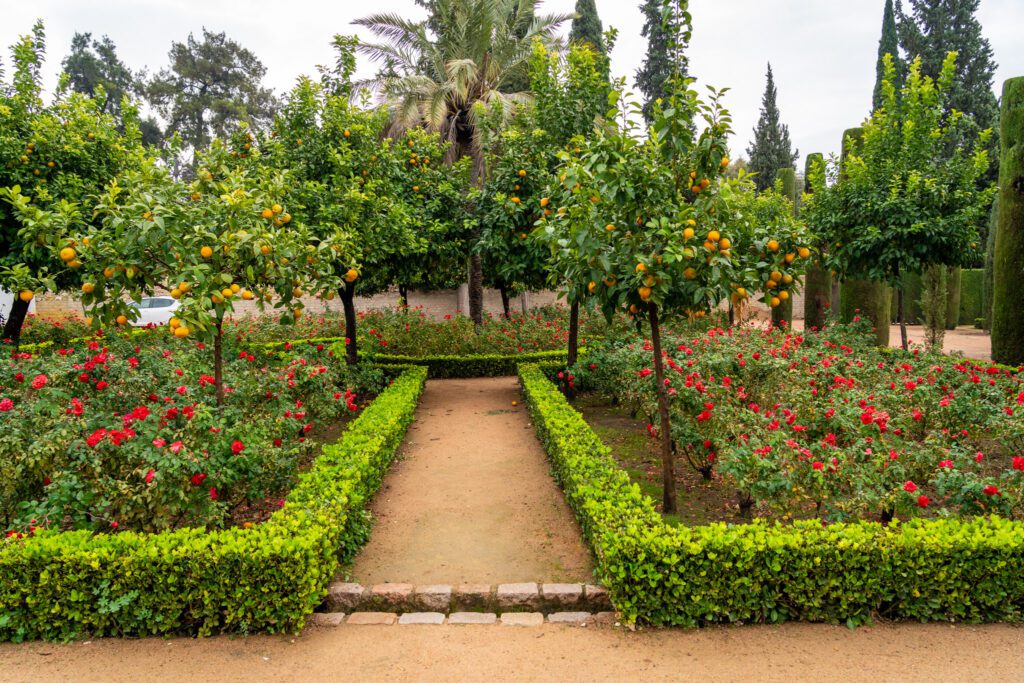
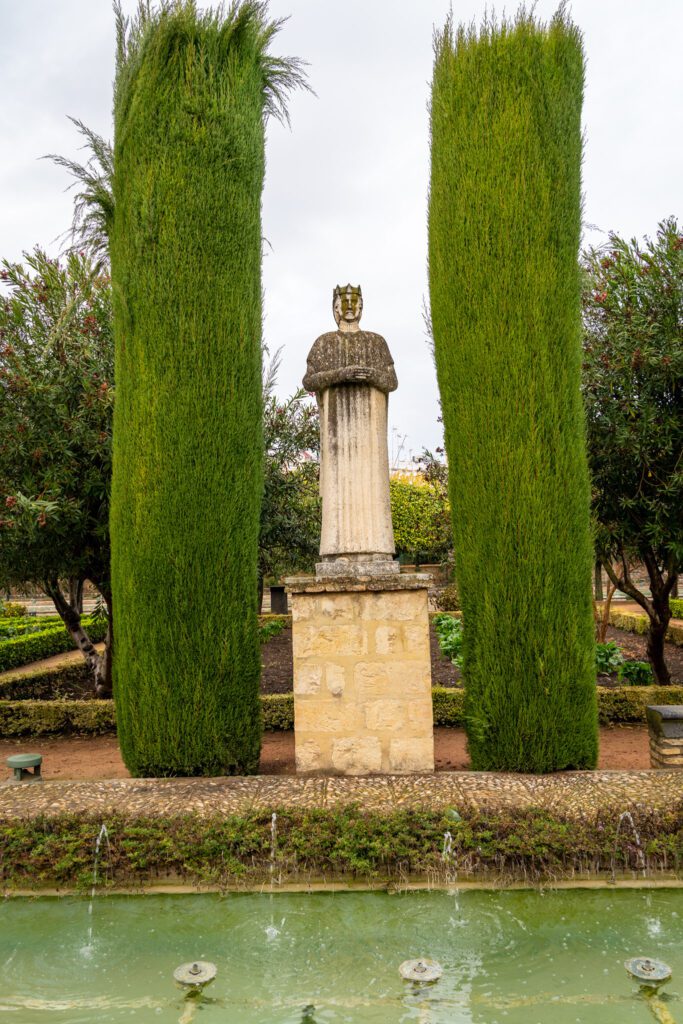
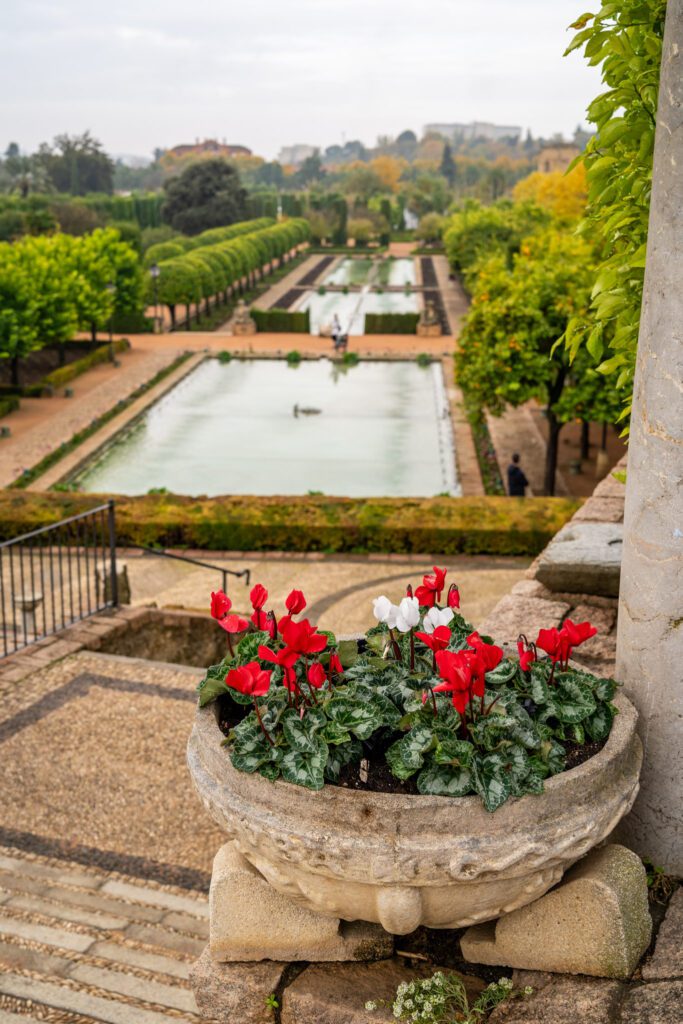
The Alcázar de los Reyes Cristianos is open daily from Tuesday to Saturday and on Sunday mornings. It’s closed on Mondays, so try not to plan your day trip for a Monday if you want to visit the palace.
You can pre-book your ticket in advance for €5 on the official website if you’re visiting by yourself. When pre-booking, you’ll need to pick a time slot to visit.
Or you can explore the palace on a one-hour guided tour like this one. On a tour, you’ll learn more about the complex’s long and fascinating history from a knowledgeable local guide.
However, if you only have the time or budget for one tour, we’d recommend the Mezquita (which is what we did). More on that in a second.
It’s easy enough to visit the Alcázar by yourself and there are plenty of signs marking the main attractions.
Puente Romano de Córdoba & Torre de la Calahorra
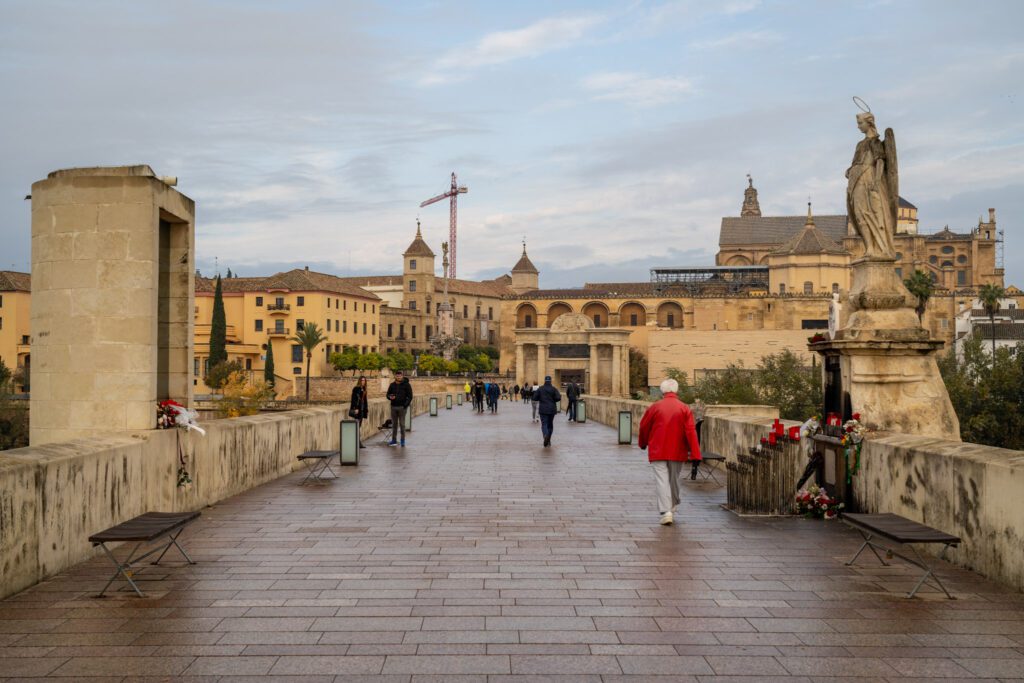
From the Alcázar, walk a couple of minutes along the river and cross over the famous Puente Romano de Córdoba (the Roman Bridge of Córdoba).
The bridge stands above the Guadalquivir River and includes 17 stone arches. Dating back to the 1st century AD, it once formed part of the Via Augusta, an important Roman road that ran from Girona to Cádiz.
The ancient arched bridge has been renovated several times over its history, but its current form has become one of the most iconic symbols of Córdoba.
The bridge is now completely traffic-free and walking across it feels like stepping back in time to the days of Roman Córdoba. There’s always a lively atmosphere and it’s a great place to snap some photos of the river and city.
Plus, if you’re a Game of Thrones fan, you may also notice that the bridge was the filming location of the Long Bridge of Volantis in the popular TV series.
At the southern edge of the bridge, you’ll find the Torre De Calahorra, a large tower dating back to the time of the Muslim era in Córdoba, that was once a fortified gate into the city.
You can climb up a narrow staircase to the top of the tower to enjoy birds-eye views over the bridge and the city’s skyline, including the Alcázar and the Mosque-Cathedral. Tickets for the tower cost €4.50 and you can buy them at the entrance
The tower also has a small museum called the Museo Vivo de Al-Andaluz, which depicts what life was like in Córdoba during the period when Christians, Muslims, and Jews lived in peaceful coexistence in the city.
The little museum is worth a quick browse on your way through, but the view is definitely the main highlight of the Calahorra Tower.
The Mosque-Cathedral of Córdoba
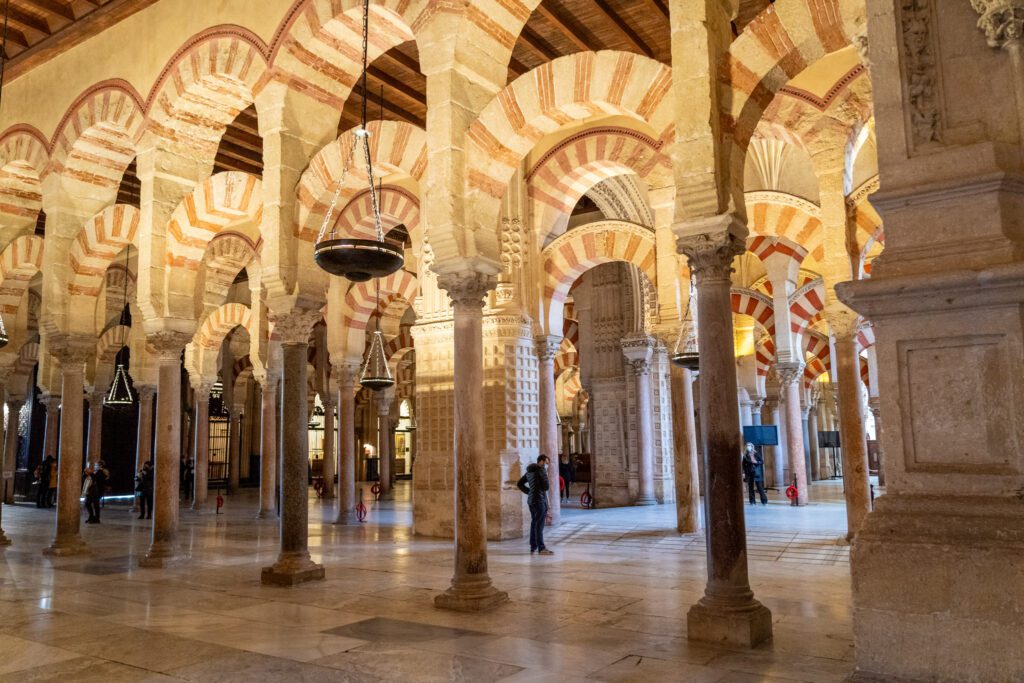
Now onto the main event, at least in our eyes.
The Mosque-Cathedral of Córdoba (Cathedral of Our Lady of the Assumption) is one of the most unique and fascinating religious buildings in all of Spain and the number one attraction in Córdoba.
Nicknamed the “Mezquita,” the Mosque-Cathedral of Córdoba features many diverse architectural styles that uniquely blend together Islamic and Christian art and culture.
It’s also one of the best preserved Islamic buildings in Europe, earning its status as a UNESCO World Heritage Site (twice!).
Similar to many other Christian churches around Spain, Italy, and the rest of Europe, this one was built on top of a religious site for the previous inhabitants of the area.
However, unlike many others, the bones of the structure were kept intact, which makes it a very unique architectural adventure.
The original Mosque was built in the 8th century when Córdoba was under the rule of Emir Abd al-Rahman I of the Islamic Umayyad dynasty, which controlled the Iberian Peninsula for several centuries.
Abd al-Rahman wanted to build a structure that rivaled the grandeur of the great mosques around northern Africa and the Middle East.
In the 13th century, after Córdoba was captured by Christian forces in the reconquest of Spain, the mosque was converted into a cathedral. Minor alterations were made, including the addition of several small chapels (they were a little short on money after that big war they were finishing up, okay?).
But it wasn’t until the 16th century that it underwent its most significant renovations, including the building of a Renaissance-style cathedral nave and bell tower, completing the unique fusion of styles you see today.
To enter the Mezquita, you’ll need to walk through the Patio de los Naranjos, a gorgeous courtyard filled with orange trees, and into Puerta de las Palmas, the main entrance hall that’s famous for its many red and white arches.
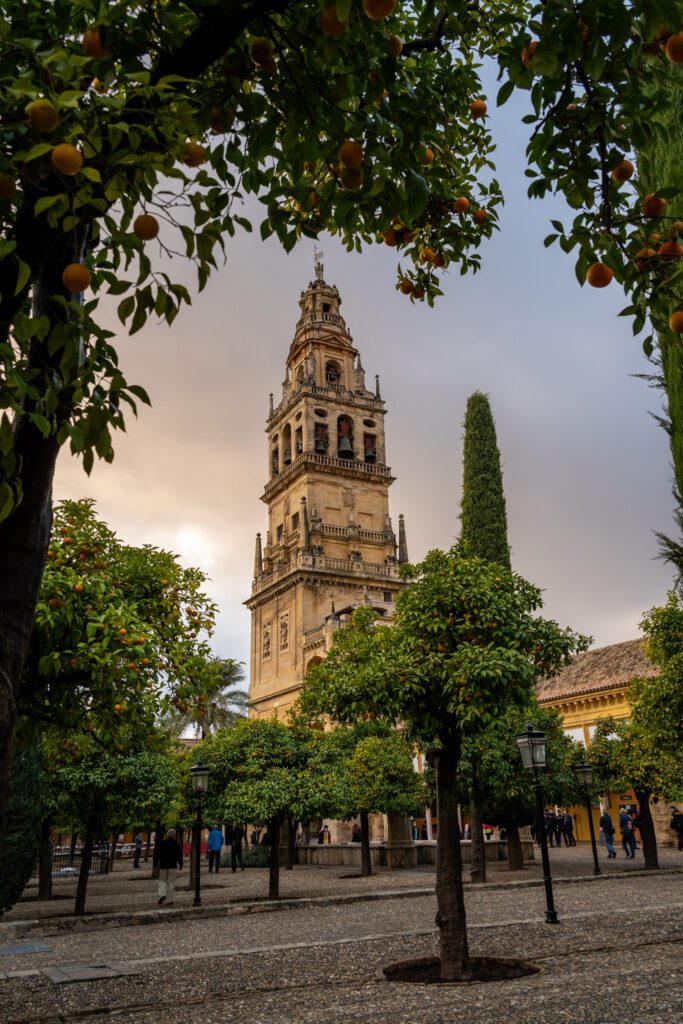
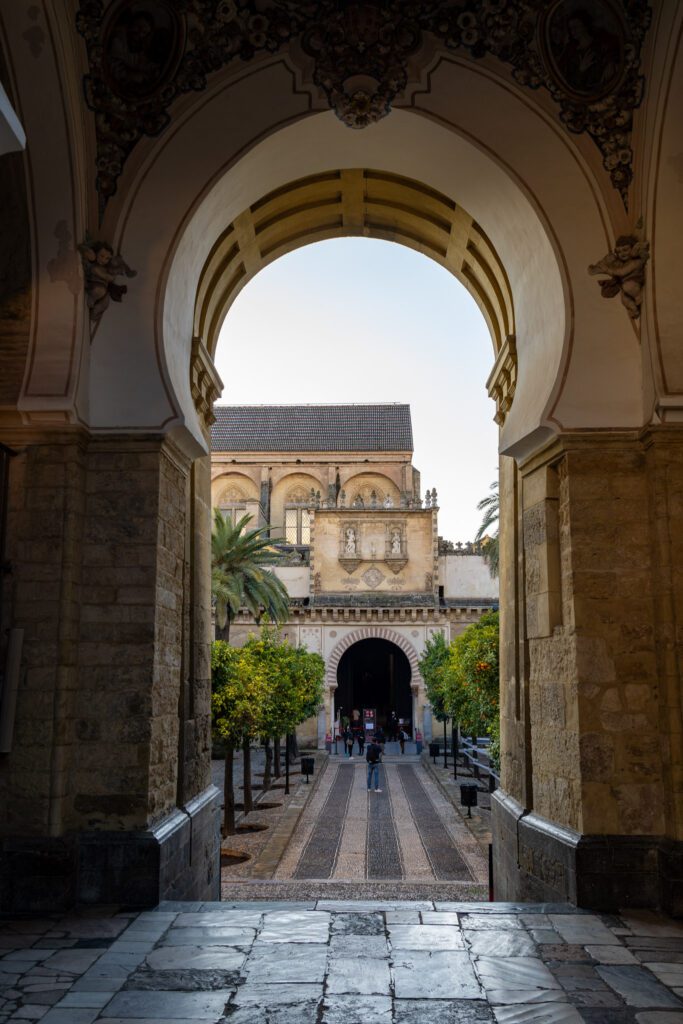
The Mosque-Cathedral’s interior is huge and packed with so much fascinating history. It can be a little overwhelming to explore on your own (and there’s not as much signage as we’d like), so we’d suggest visiting on a guided tour.
We’d recommend the tour we did. Our guide was a professional historian and gave us a bunch of great historical and cultural context around the building, which isn’t necessarily evident as you’re walking around alone.
It was also a great way to learn more about the history of Spain under Muslim rule, and about the reconquista and how the influence of that period of history is intrinsically infused in Spain’s culture, even today.
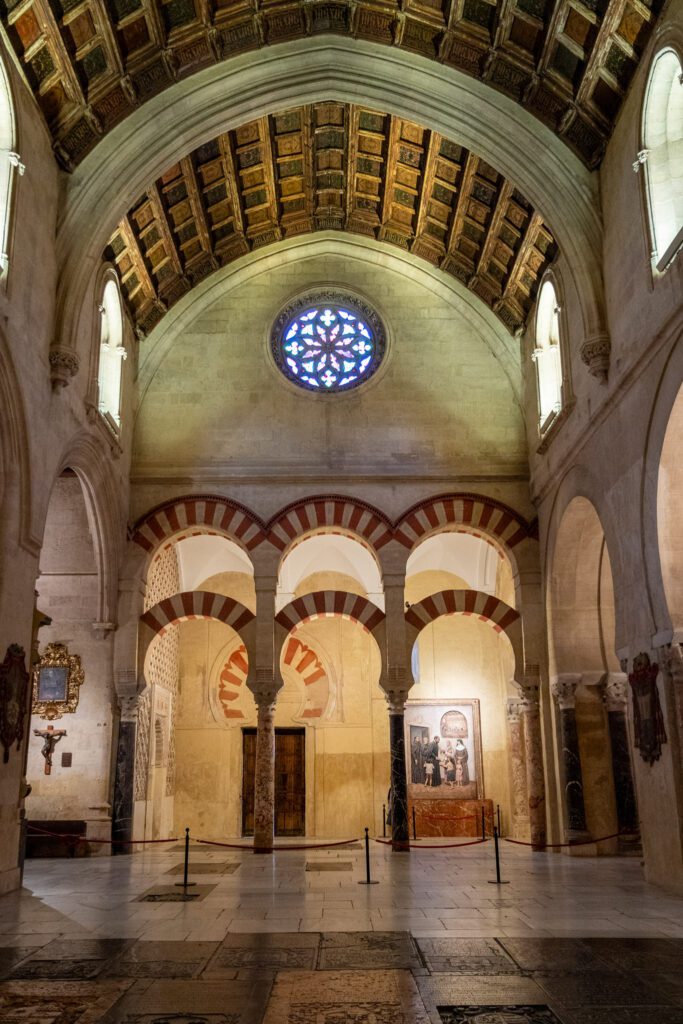
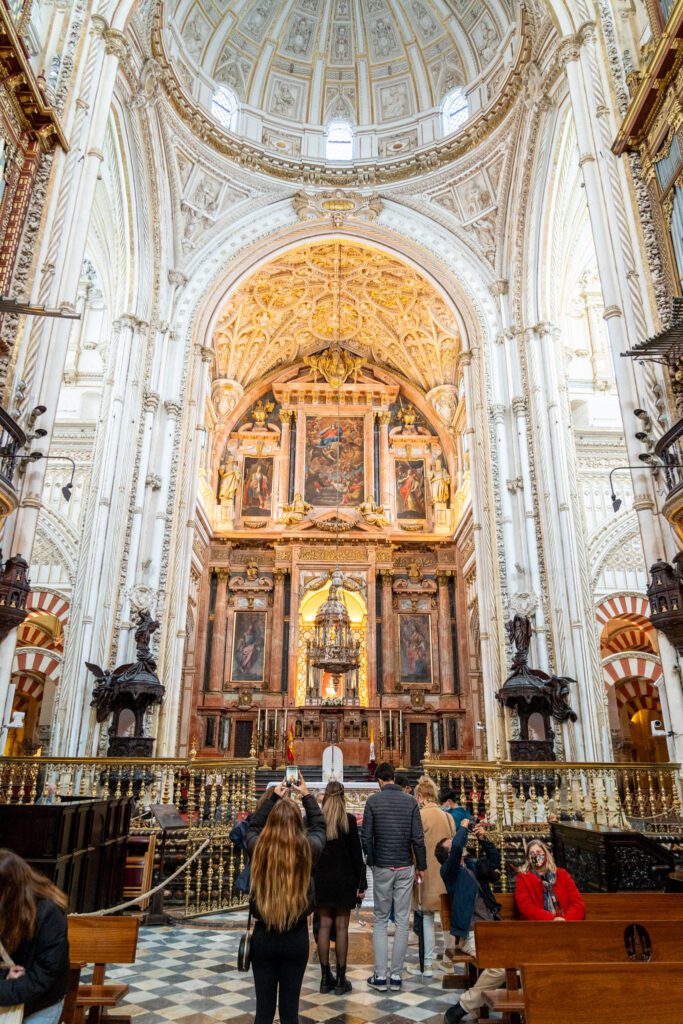
If you want to visit the Mosque-Cathedral by yourself, you can book your entrance ticket online for €13. The Mezquita is the city’s most famous attraction, so it’s best to book in advance during the high season to avoid the large ticket lines on the door.
The standard ticket to the Mosque-Cathedral does not include the bell tower. You can purchase this separately for €3 online or in the cathedral. The 54-meter-high bell tower offers fantastic panoramic views over the city and a bird’s-eye view of the main Mezquita building.
If you find yourself with extra time in the morning, the bell tower is worth the climb. But if you’re already falling behind and you’re ready for lunch at this point (which is likely), we’d skip it.
Lunch in the Jewish Quarter
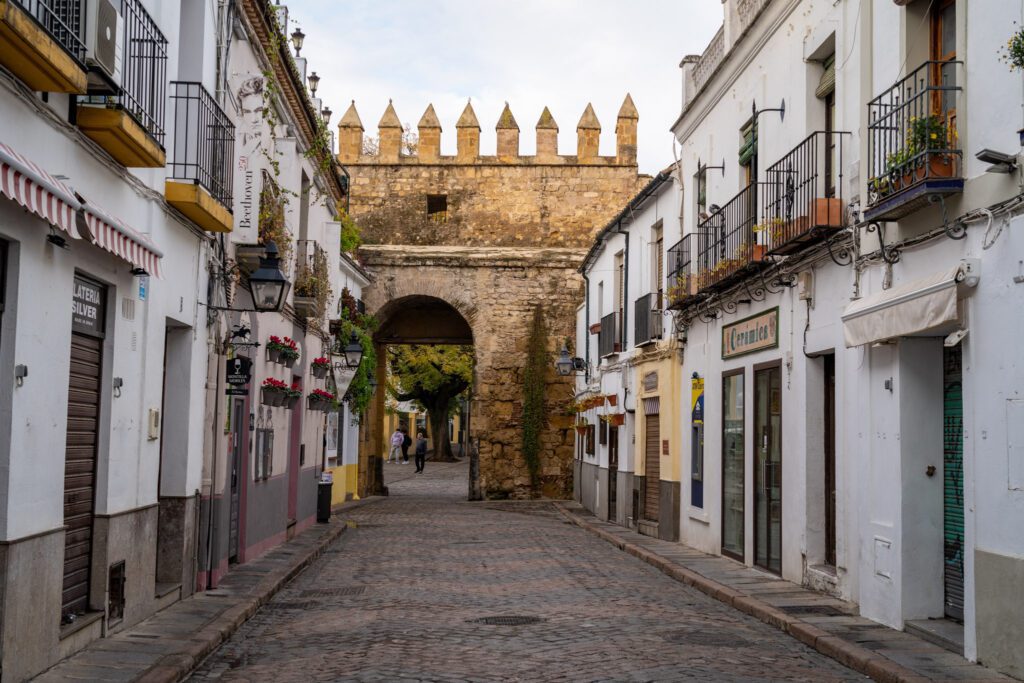
If you do take the guided tour of the Mezquita we recommended above, it will finish in the neighboring Jewish Quarter.
The Jewish Quarter – “La Judería” in Spanish – is a charming neighborhood in Córdoba’s UNESCO-listed historical center. It was once home to the city’s large Jewish community between the 10th and 15th centuries before Jews were expelled from Spain during the Spanish Inquisition.
The picturesque neighborhood is known for its narrow cobbled streets and whitewashed buildings surrounding pretty interior courtyards.
Calleja de las Flores is the area’s most famous street, thanks to its many colorful potted flowers lining the white walls.
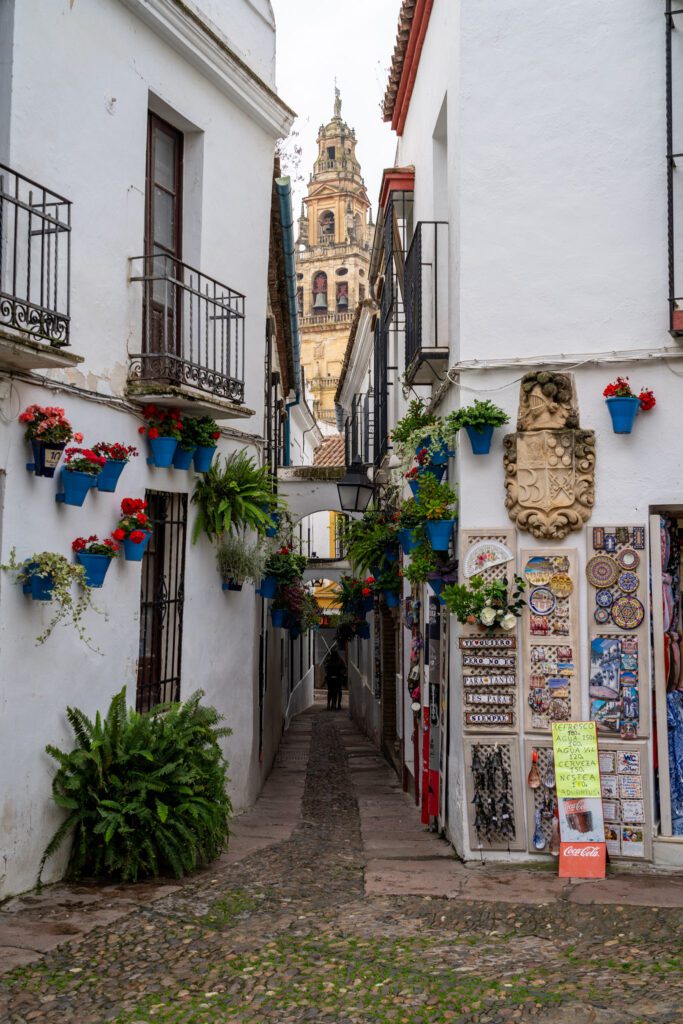
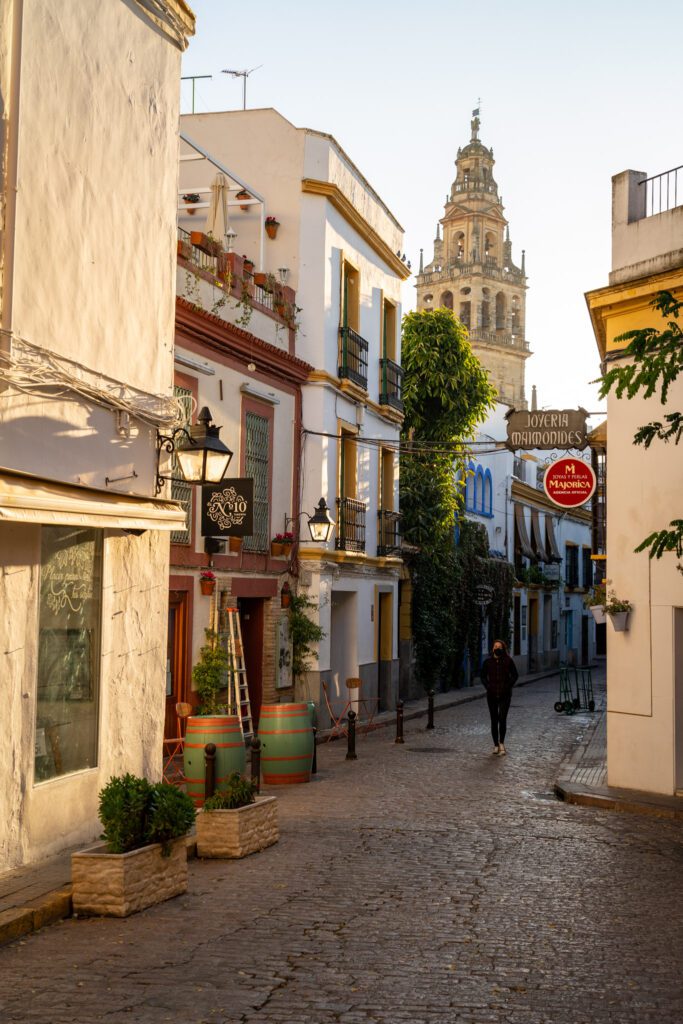
As you might imagine, given its location adjacent to the most important tourist attraction in the city, the Jewish Quarter is also packed with plenty of places to eat and drink.
Here are three restaurants that were recommended to us by various tour guides and people we met in Córdoba.
- Bodegas Mezquita – A lovely local tavern and restaurant serving Andalusian cuisine with multiple locations around the Mosque-Cathedral. Fantastic menu of sharing tapas dishes and set lunch menus. Great selection of local wines.
- Bar Santos – A tiny yet extremely popular hole-in-the-wall cafe with huge lines out the door for their famous Spanish tortillas. If you are willing to wait, you should take your food to-go because there’s basically no seating.
- Casa Pepe de la Judería – An elegant restaurant that specializes in modern interpretations of traditional dishes from southern Spain. Famous for its oxtail stew. Their rooftop terrace has fantastic views over the city and the Mosque-Cathedral. Perfect for lunch on a sunny day.
While in the Jewish Quarter, you can also pass by the Mudéjar-style Sinagoga De Córdoba, one of Spain’s best-preserved Synagogues and the only one of its kind in Andalusia. It’s free to visit so it’s worth quickly popping inside to see its many intricate carvings.
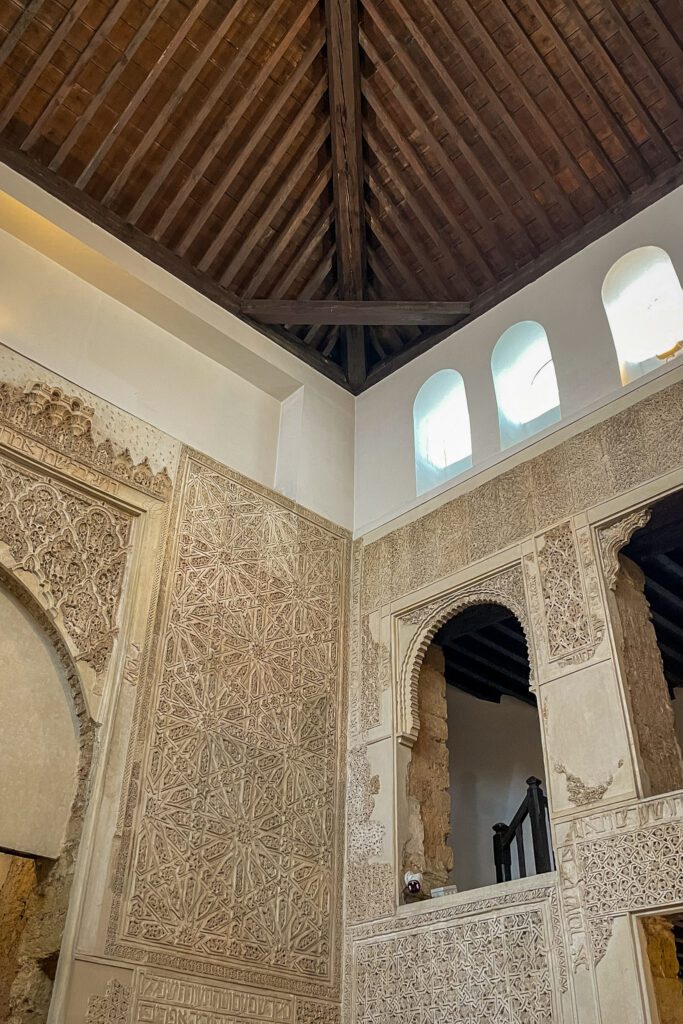
We’d also recommend stopping at the Casa-Museo del Guadamecí Omeya, which is a free museum featuring gorgeous leather artwork. We stumbled upon this spot by accident and loved how unique the art was. The museum is only open in the morning before 1:30pm and after 5pm, so time your visit accordingly.
The Roman Ruins of Córdoba
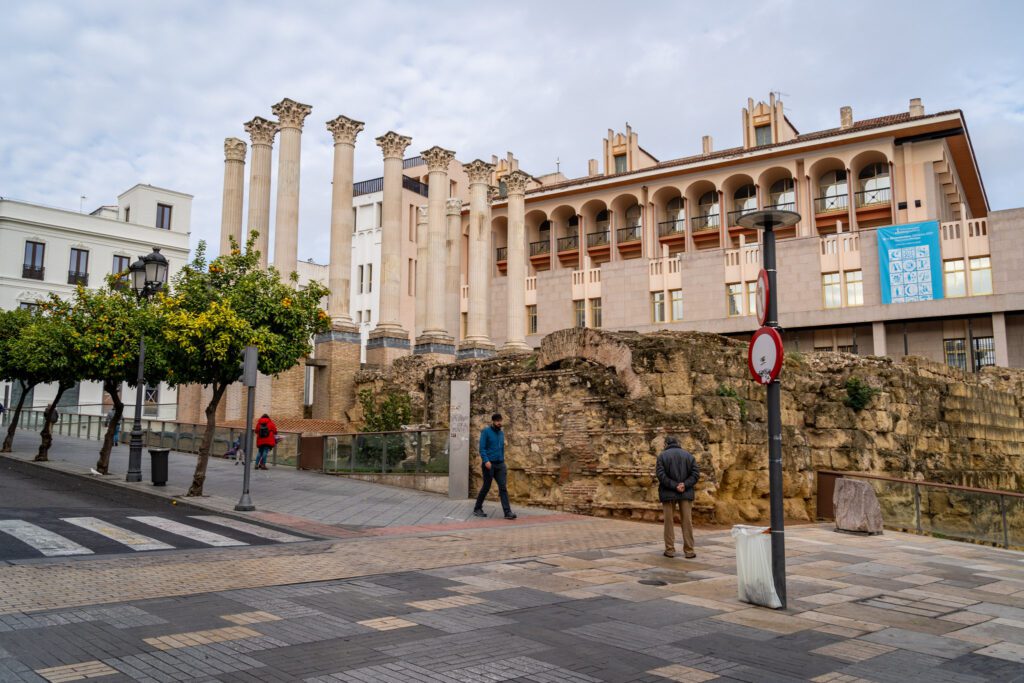
After you’ve finished in the Jewish Quarter, start making your way north through the city center and up to the Palacio de Viana (more below). On the way, you can make a short detour to see some of the city’s most famous ancient Roman ruins.
Templo Romano sits on a small hill above the historic center and houses the ruins of an ancient Roman temple, built during the reign of Emperor Claudius in the 1st century AD.
The free-to-visit archeological site now features several reconstructed pillars, so you can see just how impressive the white marble temple once stood. In its prime, it would have been visible from all over Córdoba.
Just a minute’s walk down the street from the Roman ruins, you’ll also come across Plaza de la Corredera (here on Google Maps), one of the city’s most famous and lively squares. The large and colorful square is surrounded by picturesque red and yellow arcades that house numerous local cafes, bars, and shops.
Explore The Patios of Córdoba
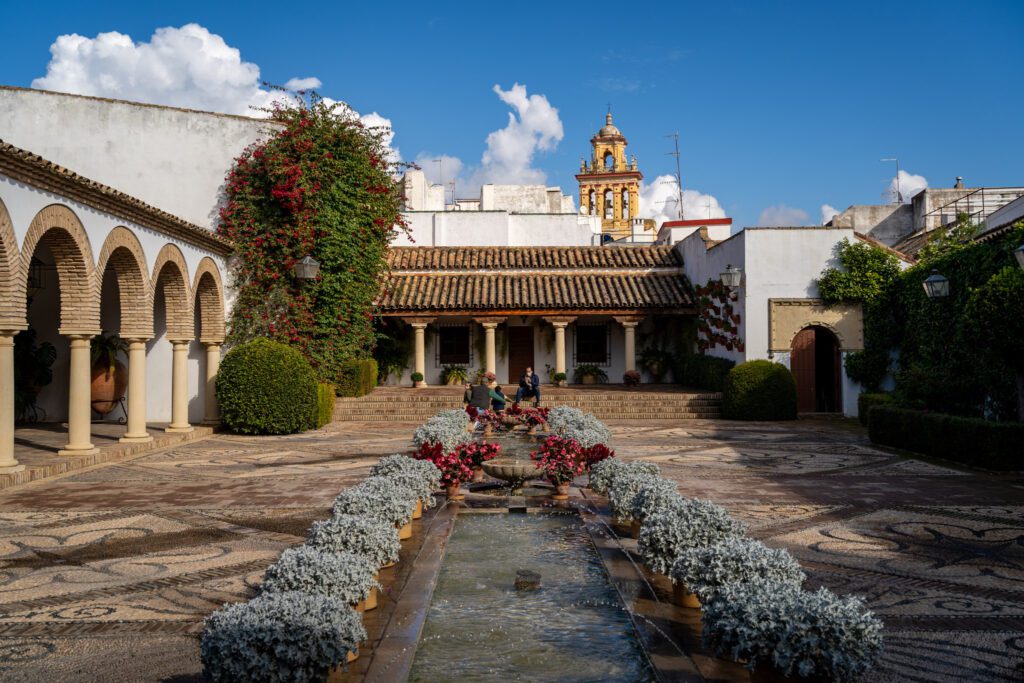
End your day by discovering some of Córdoba’s beautiful hidden patios. The Spanish city has become famous for its many stunning inner courtyards filled with colorful flowers, trees, ponds, and fountains.
The patios are an important piece of Muslim culture left over from the time of Muslim rule in the city.
Traditionally, homes during that time would have a relatively humble facade while the interior courtyards and gardens were intricately decorated and formed the center of family life.
Even after the Christian reconquest of the city, this architectural structure survived and Córdoba’s patios have become more and more elaborate over time. The patios are now considered a World Cultural Heritage Site by UNESCO.
Since 1918, Córdoba has even hosted an annual patio festival (Fiesta de los Patios) each spring, in which locals compete to have the prettiest courtyard in the city. During the festival, many private patios open their doors to the public for free, making it a great time to visit the city.
But even if you’re not in Córdoba during the festival, there are still plenty of patios you can visit throughout the rest of the year.
Palacio de Viana
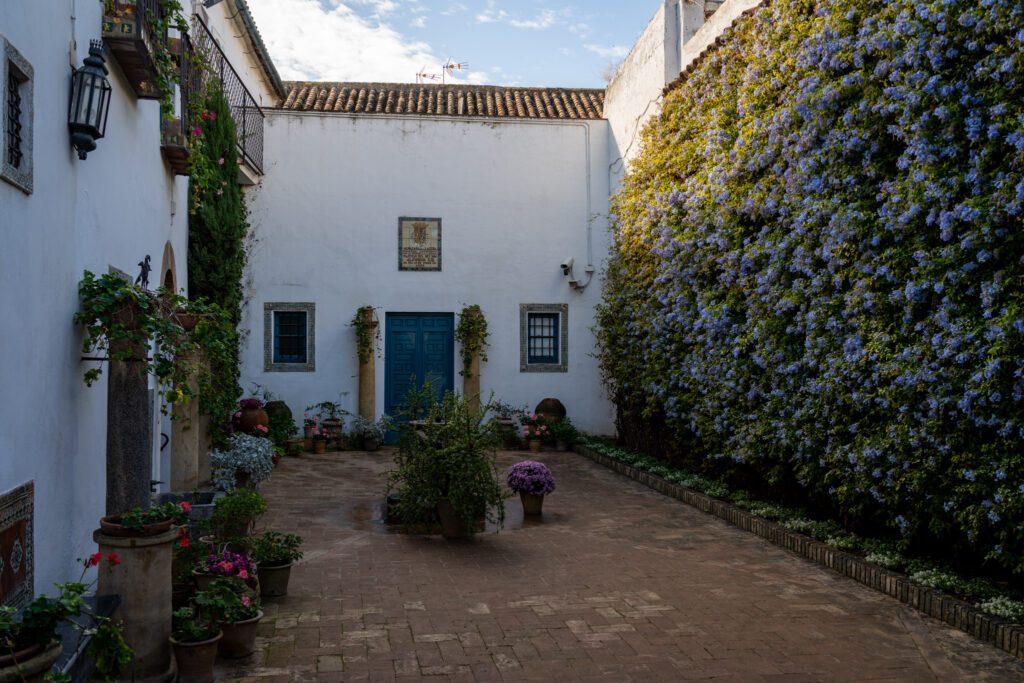
During our time in Córdoba, we visited Palacio de Viana, a grand 15th-century stately home with 12 beautiful patios, and would highly recommend it.
The palace has gained the nickname “the Museum of Courtyards” due to having the largest collection of patios in the city. Each of the patios represents various periods of the property’s history and the tastes of its owners over the last five centuries.
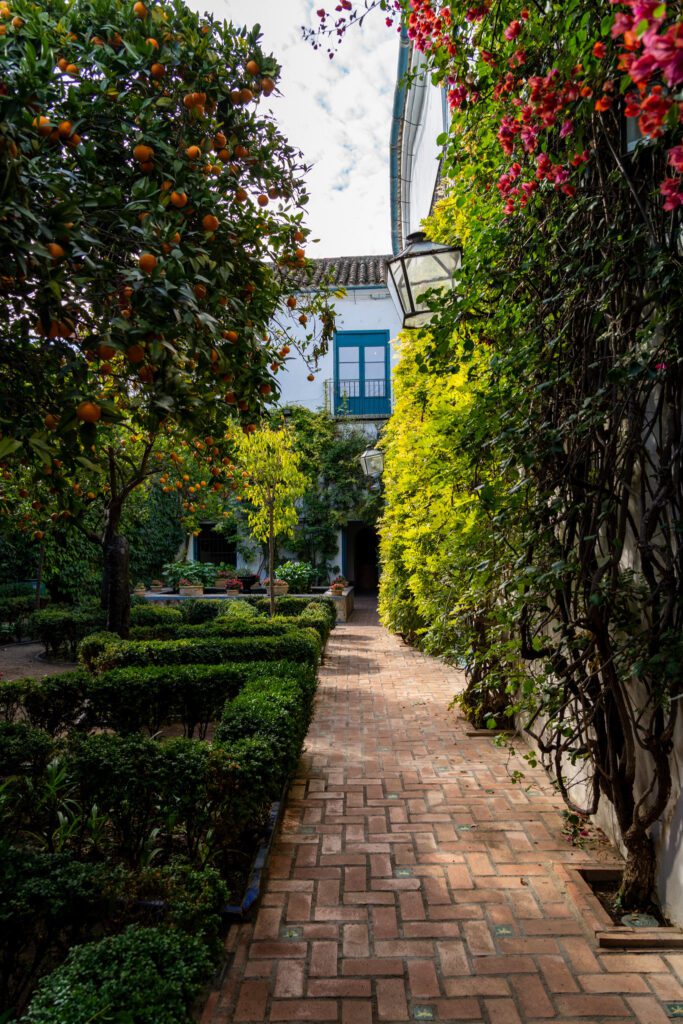
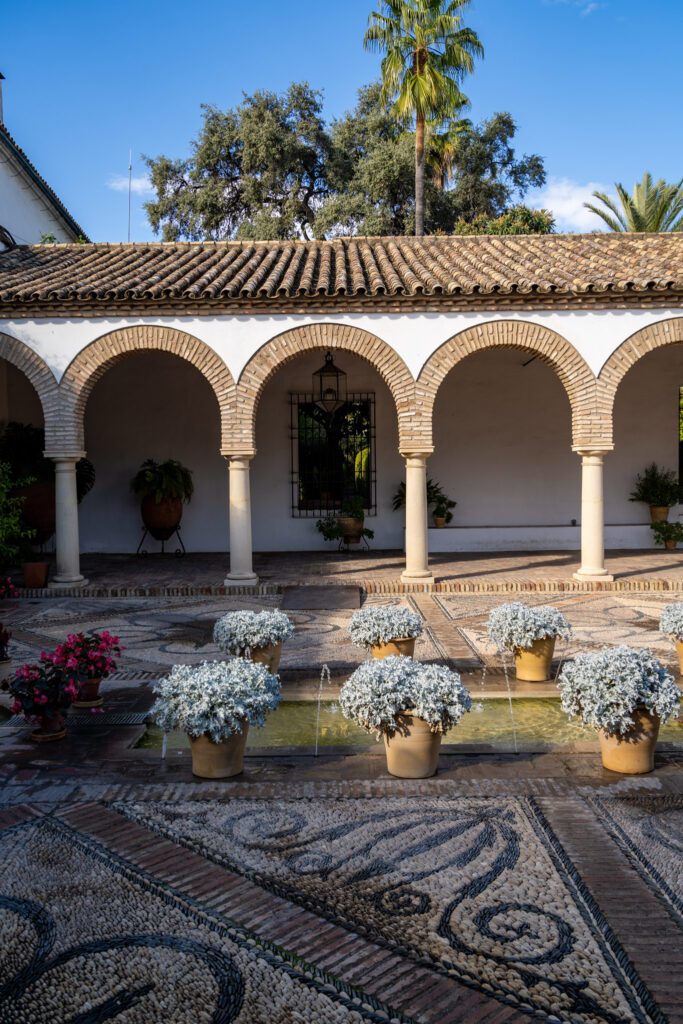
You can buy your tickets for Palacio de Viana’s patios at the door or online in advance. If you visit on Wednesdays between 2pm and 5pm, the patios are free to visit (other than in July and August when they shut at 3pm).
You’ll need a separate ticket to visit the palace’s interiors, but with just one day, you probably won’t have time to fit this in.
The San Basilio District
Another place to see some of the city’s best patios is the charming San Basilio neighborhood in the south of the historic center.
Note: If you do plan on visiting San Basilio instead of the Palacio de Viana, you may want to skip the Roman ruins as they’re in the opposite direction. Or visit the ruins after the patios instead.
Calle de San Basilio is home to many stunning private patios that often open their doors to the public throughout the year. You can take a stroll down the street and see which ones are open during your visit – numbers 14, 17, 20, and 40 are some of the best if they are open.
Most patios here don’t require a ticket, but the owners do have a donation box at the gate where you can leave €1-2 tip.
However, you never know if or when these private patios will be open, so it can be a risk to visit this way when you have limited time in Córdoba.
Another option is to buy a ticket for the Ruta De Patios, which is a collection of five award-winning courtyards in the San Basilio neighborhood. You can buy the ticket at Calle de San Basilio 14 and you’ll get a map of the patios you can visit. All five are located just a few minutes walk from each other.
A visit to Calle de San Basilio 44 is also a must. This is the headquarters of the patio association and is home to one of the most colorful and picturesque courtyards in Córdoba. The patio is open from 10:30am-2pm and 5-8pm most days and is always free to enter.
Dinner at Mercado Victoria
Finally, finish your day in Córdoba with a well-deserved dinner at Mercado Victoria, a cool modern food hall that feels like it could be in Brooklyn or the Arts District in Los Angeles.
Located right in the heart of Victoria Gardens, the market building itself dates back to 1877 and was originally the booth of the Circle of Friendship at the Córdoba Fair.
Now the unusual building is home to the very first gourmet food market in the Andalucia region, with 20+ stalls selling a variety of Córdoban, Spanish, and international cuisines.
From traditional Andalusian “salmorejo” (like a thick gazpacho) and local artisan cheeses to Italian pizzas and American hamburgers, there are plenty of options to choose from. It’s a good dinner spot for picky eaters or groups with diverse tastes.
The market also has plenty of seating, a nice local wine and sangria menu, and regular live music, so it’s a fun spot to grab a drink or two and enjoy the lively evening atmosphere.
The market is just a 10 minute walk back to Córdoba train station, making it the ideal stop to end the day before catching your train back to Sevilla.
What to Do With More Time in Córdoba
If you do end up having more than a day in Córdoba, there are a couple of other attractions you can add to expand this itinerary.
The Museo Arqueológico de Córdoba
Located inside a beautiful Renaissance-style palace, the Museo Arqueológico de Córdoba is one of the most complete archaeological museums in Spain and is worth a visit if you have the time.
The museum houses hundreds of archaeological remains and artifacts found in Córdoba and the surrounding province.
The exhibits range from prehistoric times up to the period of Muslim rule into the Middle Ages, giving a fantastic overview of Córdoba’s history.
You can even visit the excavated remains of the city’s 2,000-year-old Roman theater, which sits in the museum’s basement. The ancient ruins were discovered when building work to expand the museum began.
The museum is free to visit for EU citizens and €1.50 for everyone else. All of the exhibits have detailed explanations in Spanish and English. We’d recommend giving yourself around an hour or two to see the main displays.
Take a Day Trip to Medina Azahara
Medina Azahara, or the Madinat al-Zahra, is a magnificent fortified palace-city built on the outskirts of Córdoba in the 10th century by Arab ruler Abd-al Rahman III. For a brief time, it took over from Córdoba itself as the capital of the Caliphate of Córdoba.
This palace is the only one of Córdoba’s main historic attractions that isn’t walkable from the city center. Instead, it sits around 8 km to the west. Realistically, it’s too much to fit into just one day, but with a little extra time in Córdoba, it’s definitely worth a visit.
The impressive city was built as a symbol of power – the ruler wanted to project power to the other kingdoms to the east and in North Africa – and housed a complete urban complex, including a royal castle, a mosque, government buildings, living quarters, gardens, workshops, Arab baths, and more.
Some of the palace ruins were excavated in the early 1900s. It is now one of the largest archaeological sites in Spain and even a UNESCO World Heritage Site.
You can visit Medina Azahara on a guided tour (this is with the same company we visited the Mezquita with, who we liked).
Entrance to Medina Azahara is free for EU citizens and €1.50 for everyone else. You can reach the Medina by driving or taking the daily tourist bus.
Driving takes just 10-15 minutes from central Córdoba. However, the ruins are located a couple of km from the free parking area, so you’ll need to get on a shuttle to reach the main site (an additional €3).
The best option if you’re carless is to jump on the tourist bus that leaves daily at 11am (Tues to Sun) from Avenida Alcazar in central Córdoba.
A round trip costs €10 and gives you 2.5 hours to visit the complex. It’s best to book the bus at least a day in advance from the tourist office.
